Australia 2022 "Beautiful Continent"
| << previous | back to index | next >> |
| Issue Date | 23.02.2022 |
| ID | Michel: Scott: Category: Ot |
| Design |
Simone Sakinofsky, Australia Post Design Studio Photographs: Daniel Willans, Wilpena Pound, Marco Bottigell, Dangar Falls. |
| Stamps in set | 4 |
| Value |
$1.10 Blue Mountains, NSW $1.10 Flinders Ranges, SA $1.10 Ningaloo Coast, WA $1.10 Gondwana Rainforests, NSW |
| Size (width x height) | 37.5mm x 26mm |
| Layout | Sheets of 50 |
| Products | FDCx1, MCx4, Bookletx1, Gutter Pair stripes x4 |
| Paper | Tullis Russell Red Phos |
| Perforation | 13.86 x 14.6 |
| Print Technique | Offset lithography |
| Printed by | EGO |
| Quantity | |
| Issuing Authority |
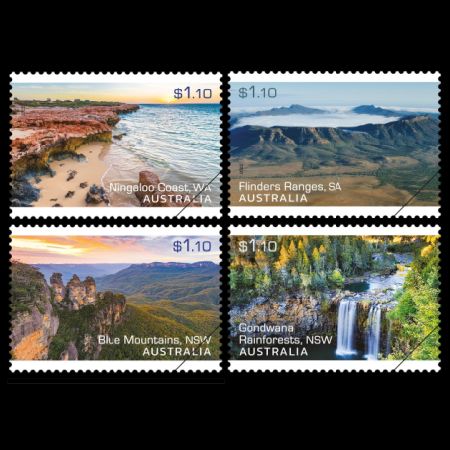
On February 23rd 2022, the Post Authority of Australia issued a set of 4 stamps "Our Beautiful Continent". This issue features landscapes from three UNESCO World Heritage properties and another recently included on the World Heritage Tentative List.
- The Greater Blue Mountains Area (inscribed onto the World Heritage list in the year 2000) is a biodiverse region of sandstone plateaux,
escarpments and gorges dominated by temperate eucalypt forest.
These three prominent sandstone peaks formed around 200 million years ago and are situated on the north escarpment of the Jamison Valley.
According to the Dreamtime, the peaks were once three sisters who were turned to stone and now watch over the land of the Darug, Gundungurra, Wiradjuri and Dharawal peoples. - The Flinders Ranges (inscribed onto the World Heritage list in the year 2001) is a semi-arid mountainous landscape. It features diverse landscapes, rich biodiversity and an exceptional geological record of the dawn of animal life on Earth.
- The Ningaloo Coast (inscribed onto the World Heritage list in the year 2001) supports exceptional biodiversity of marine and terrestrial life and is one of the longest near-shore reefs in the world with an extensive karst system and network of underground caves and water courses.
- The Gondwana Rainforests (inscribed onto the World Heritage list in the year 1986) includes important volcanic
features and it supports the most extensive subtropical rainforest in the world.
It is the principal habitat for many rare and threatened
rainforest species, some with origins in the ancient supercontinent Gondwana.
It was so-named because the fossil record indicates that when Gondwana existed it was covered by rainforests containing the same kinds of species that are living today.
There is a concentration of primitive plant families that are directly linked with the birth and spread of flowering plants over 100 million years ago, as well as some of the oldest elements of the world's ferns and conifers.
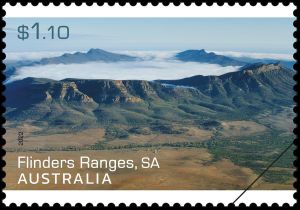 |
| Landscape of the Flinders Ranges on stamp of Australia 2022 MiNr.: , Scott: |
Sprigg's discovery was extremely important, as it was the first time the fossilised remains of an entire community of soft-bodied creatures had been found in such abundance anywhere in the world.
Sprigg's discovery was so significant that one genus of the fossils was named after him – Spriggina (shown on one of the stamps of Australia 2005 - below) and the Ediacaran Period was named after the location where the fossils were found.
The fauna is usually referred to as the Ediacara Fauna or the Vendian Fauna.
The Vendian Fauna gets its name from a site along the White Sea in Russia which has a similar
fauna to the fossils found in Australia.
The Russian site was actually found a little bit earlier.
This discovery gave scientists a new understanding of the evolution of life on earth, as well as a better understanding of how fossils of organisms with soft tissue can become preserved in the fossil record.
The fossils of this period resemble the flatworms, soft corals and jellyfish we know today and range in size from a few centimetres up to a metre long.

Tha animals on the stamps above are:
- Tribrachidium – thought to be related to the echinoderms (a group that includes starfish, sea cucumbers, sea lilies, etc.). They differ from echinoderns in having tri-radial symmetry instead of pentaradial symmetry.
- Dickinsonia – thought to be a flat worm.
- Spriggina (named after Reginald Sprigg) – thought to be an early Arthropod – due to the segmented body plan with segments grouped into a head, thorax, and pygidium (essentially a tail).
- Kimberella – thought to be an early mollusc.
- Inaria is thought to be an early cnidarian – likely related to modern sea anemones.
- Charniodiscus – they look like sea fans (another type of cnidarian) – but the paleontologists who have studied them think that they are an off-shoot of animal life and are not related to Cnidarians at all. Their shape is likely an example of convergent evolution – both groups being stationary filter-feeders.
The Ediacara fauna, also called the Ediacara biota is a unique assemblage of
soft-bodied organisms preserved worldwide as fossil impressions in sandstone from the Ediacaran Period
(approximately 635 million to 541 million years ago)—the final interval of both the Proterozoic Eon
(2.5 billion to 541 million years ago) and Precambrian time (4.6 billion to 541 million years ago).
Traditionally, these fauna have come to represent an important development in the evolution of life on Earth,
because they immediately predate the explosion of life-forms at the beginning of the Cambrian Period 541
million years ago.
These animals were the precursors of organisms with skeletons, the appearance of which marked the end of
Precambrian time and the beginning of the Phanerozoic Eon (541 million years ago to the present).
| FDC | Strips of Gutter Pairs | Maxi Cards |
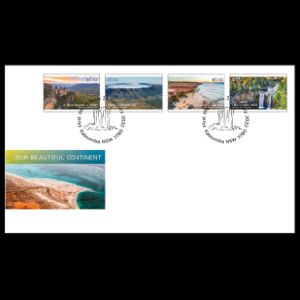 |
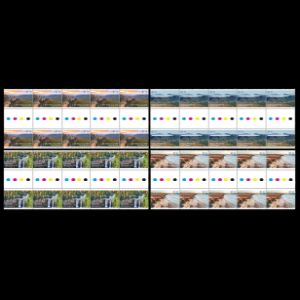 |
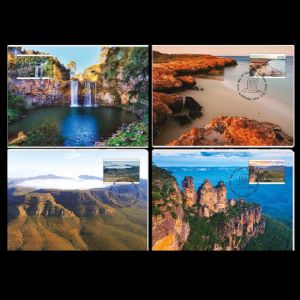 |
| Booklet of 10 | Presentation Pack | |
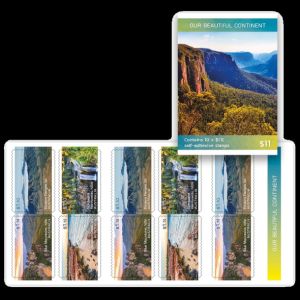 |
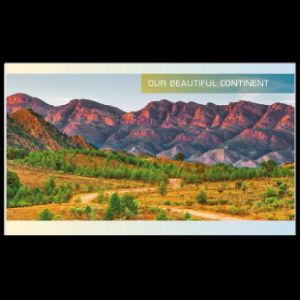 |
References:
- [R1] Technical details and basic description: australiapostcollectables.com.au.
- [R2] Ediacara fauna: awe.gov.au, austhrutime.com, Encyclopedia Britannica, Wikipedia, The Ediacaran Period: Glimpses of the Earth's Earliest Animals Youtube lecture by Mrs. Calla Carbone for the Royal Tyrrell Museum of Palaeontology in Canada.
- [R3] The Gondwana Rainforests : UNESCO. Wikipedia.
Acknowledgements:
Many thanks to Dr. Peter Voice from Department of Geological and Environmental Sciences, Western Michigan University, for the draft page review and his very valuable comments.
| << previous | back to index | next >> |